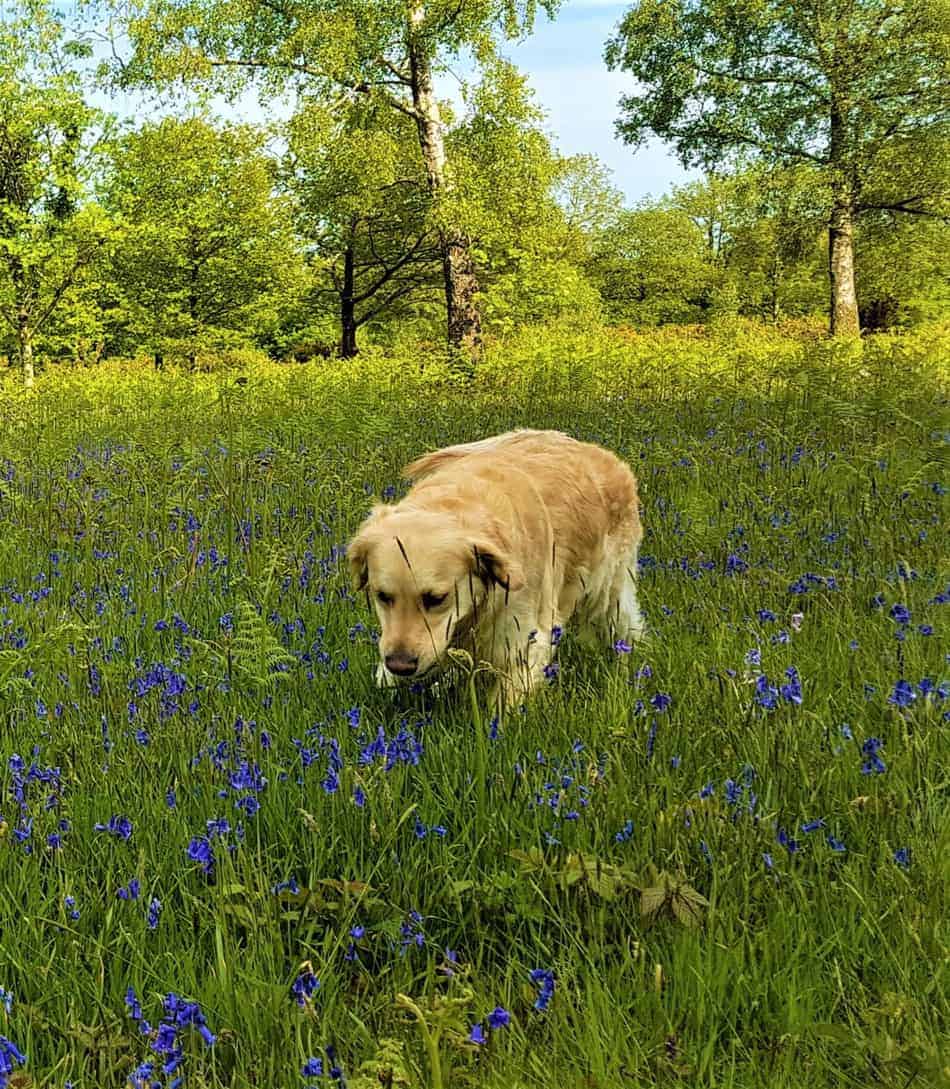We’ve all been there, you’re sound asleep, but then you hear the telltale tic-tac of claws on the floor again. The question runs through your mind, why does my dog keep pacing around the house.
Dogs will often pace around the house to express their anxiety or boredom. Pacing happens when your dog is not sure what to do with itself, whether this is brought on by boredom or something that has made them anxious.
When dogs walk aimlessly around the house, it can become quite an irritation for owners. Dogs will speak to us through their actions and so it is up to us as owners to figure out what they want. Here we cover why your dog is pacing around the house and what you can do to help alleviate it.
Contents
- 1 Why Does My Dog Keep Pacing
- 1.1 Your Dog’s Pacing Could Be Because They Are Anxious
- 1.2 Your Dog’s Pacing Could Be Because They Are Bored
- 1.3 Your Dog’s Pacing Could Be Because They Are Excited
- 1.4 Your Dog’s Pacing Could Be Because They Are Looking For Something
- 1.5 Your Dog’s Pacing Could Be Because They Have Too Much Excess Energy
- 1.6 Your Dog’s Pacing Could Be Because They Are In Heat (Season)
- 2 How To Tell If Your Dog’s Pacing Is More Serious
- 3 Conclusion
Why Does My Dog Keep Pacing
It’s never fun to think about the serious conditions that pacing can indicate, and the internet is ready to bombard you with worst-case scenarios as soon as you look up information.
Thankfully, however, most pacing in dogs is typically due to a fairly mundane cause. Below are six of the most common reasons your dog may be pacing.
Your Dog’s Pacing Could Be Because They Are Anxious
The first and most obvious reason your dog may be pacing around the house a lot is due to their nerves.
When a dog becomes anxious, nervous, or otherwise scared, it’ll often take to pacing back and forth around the house in a somewhat panicked-looking way. They may also shake or tremble. This can often scare their owners and make them think that there must be something horrible going on!
Dogs have anxiety and can even have panic attacks, just like humans. If you think that’s what is happening to your dog, the best thing you can do is:
- Grab high-value treats, their favorite toy, or something else they really enjoy. Items like this can take their mind off of whatever is causing them to be anxious.
- Redirect their attention to you as best you can. Dogs who are very anxious may not immediately respond but be persistent.
- Try having a training session or playing a game. Persist even if your dog isn’t totally going along with it. Trying to focus your dog’s mind is the main way to reduce this form of stress.
- Keep them entertained for at least a few minutes. It will take that long, at minimum, for your dog’s body and brain to calm back down.
Key Points: The key points to helping a dog with anxiety are redirection and time. They’re helpful tools to keep in mind.
Your Dog’s Pacing Could Be Because They Are Bored
The next, and the most likely reason is your dog is getting bored or restless. Restlessness can appear anytime you are relaxing in your home. It normally occurs when you haven’t taken them out for a walk or interacted with them for a while.
Dogs need mental stimulation just like humans, and the smarter your dog is, the more stimulation they’ll need. Most of us are probably familiar with being so bored that you just get up and walk around—this is just your dog doing the same thing.
Get him a new toy, take him on a walk, or find other ways of stimulating him, and the behavior should stop. There are even puzzle games you can get, which you insert treats into. These can distract dogs for hours and test how smart your dog might be.

Your Dog’s Pacing Could Be Because They Are Excited
Another common reason that your dog is pacing could simply have to do with him being excited! If it’s getting close to dinner time or any other part of his daily routine that he enjoys, it’s common to see your dog pace excitedly around in anticipation.
If the pacing consistently happens before something he gets excited about, it’s likely of little concern. I know that when it’s my dog’s dinner time he will often come and stare at me or pace up and down, wondering when ill make a move. Once he is satisfied he will be much less restless.
Pro Tip: If you are lucky enough to have a garden or outdoor area. Try Walking around this area or even sitting outside with your dog for a few minutes. Often this can settle them more easily, as sometimes all they wanted was a quick sniff of their territory. This article on “Why Does My Dog Smell Everything On A Walk” could be of interest if you want to learn more about your dog’s sniffing habits.
Your Dog’s Pacing Could Be Because They Are Looking For Something
This is more unique behavior than the others in this list, but if you notice your dog pacing around one afternoon out of the blue, then he may just be looking for something like:
- A lost toy
- A piece of food he heard drop
- Another dog, if there is usually one in the house
- Even just a specific human
This one is fairly easy to rule out. Just follow your dog around for a minute and see if he leads you to an obvious find like a toy that is stuck out of his reach. As dogs use their nose to find pretty much everything they want to find, you will most likely see your dog following a scent or trail. They will be sniffing the ground furiously and you may even see a runny nose start to appear…gross I know. Here’s an article on “How Long Can A Dog Follow A Scent”, there is lots of extra information on how dogs are able to smell including links to research articles on dog sniffing experiments.
Your Dog’s Pacing Could Be Because They Have Too Much Excess Energy
Just like mental stimulation, different breeds of dogs require different levels of physical stimulation. If your dog is feeling starved for exercise, he’ll often engage in:
- Pacing
- Destructive behaviors (ripping toys, chewing furniture, etc.)
- Restless barking or whining
- Sudden bursts of activity that last a few minutes
A dog that is pacing because it needs exercise can be cared for just by giving them a walk (or three, if you own a border collie!).
It’s important to mentally stimulate as well as physically stimulate them. Walking your dog is just half the process, how you walk your dog will make a big difference to their energy levels. For example off lead, walking gives a high energy burn when compared to the time spent out. You could spend an hour walking your dog on the lead and 30 minutes letting them run around a field, it’s more than likely your dog will burn more energy running off lead for less time.
Of course off lead walking is not always possible, especially if you live in built-up urban areas. Ensure your dog is able to smell everything they want to during an on-leash walk. Obviously, drag them away from anything they shouldn’t be smelling but let them investigate smells and lead you along their own scent route. This will give your dog lots of mental stimulation and help with their behavior and energy levels at home.

Your Dog’s Pacing Could Be Because They Are In Heat (Season)
If you happen to have an unspayed female dog that starts pacing out of the blue, then the first thing to check is whether or not she is in heat.
Female dogs in heat can be suddenly “possessed” by quite a bit of frantic energy, and she may begin pacing since she’s trapped and cannot go looking for a mate. You’ll simply have to wait it out; the end of her heat cycle should bring an end to the pacing.
The topic of whether you should take your dog out whilst they are in heat is very much a debated subject. Although there are not any specific laws in the UK dictating that you cannot walk a dog that is in season you should always check your own countries laws including any state laws in the USA.
Despite this debate, the fundamental answer is you must exercise your dog even whilst they are in heat. In some cases a female dog’s season can last for 4 weeks, it is simply cruel to keep a dog locked up for that long and so any attempt to stimulate them mentally and physically is vital for their health. However, taking the correct precautions is important and ensuring you are safe and are aware of the consequences of doing so. Male dogs can become unpredictable around females in season, take a look at this article we wrote all about what to look out for if you are walking your dog in heat. “Can You Walk A Dog In Heat”
How To Tell If Your Dog’s Pacing Is More Serious
If your dog’s pacing is chronic, happens all day, or generally cannot be traced back to any of the acute causes above, then it may, unfortunately, be time to consider more serious possibilities.
None of the below is medical advice; that being said, if your dog is exhibiting some of these symptoms along with pacing, then it is time to get in touch with a vet.
They Have Sudden Shifts in Behavior
The number one biggest sign of a serious issue in dogs is a sudden change in behavior. Whether that means becoming strangely aggressive, overly timid, or anything else, a persistent shift in behavior is enough to warrant a trip to the vet.
They Are Panting While Pacing
Pay close attention to your dog while he paces. If he appears to be frequently panting and just won’t settle down, then it’s also time to pay a visit to the vet.
According to PetMD panting and pacing are often seen in dogs with Cushing’s Syndrome, a condition caused by a tumor on the pituitary gland in the brain or on the adrenal gland in the kidneys.
Dogs that are nearing the end of their natural life are prime candidates to develop Cushing’s Syndrome. If your dog is elderly, then this may be the likeliest culprit, and you’ll need to speak with a vet.
They Seem Confused or Don’t Recognize You
Another distressing symptom that can coincide with pacing is a dog’s sudden loss of memory or awareness. He may:
- Look confused at his surroundings
- Act as if he is trying to figure things out
- Not recognize you and become timid or aggressive
These, along with pacing, are common signs of dementia in elderly dogs. It would be wise to speak to a vet. However, if he doesn’t appear to be in any pain and is not being aggressive, then he may continue to live a happy life for some time.
They Are Snapping at the Air Constantly
The last symptom we’ll talk about today is what’s called “fly snapping” or simply just “air snapping.”
It’s almost exactly what it sounds like—you might see your dog snapping at the air as if flies or other pests were bothering him. In the right contexts, air snapping is not an issue, and he may just legitimately be trying to catch flies.
If your dog is snapping at the air when there are no bugs, and it continues more than once, then it may be a sign of epilepsy. These “fly snapping” behaviors are actually minor seizures (or precursors to them). Check out PetMD for more details on fly snapping syndrome
If you notice this behavior along with pacing, then you should get your dog into the vet immediately. Epilepsy can be treatable in dogs with the right medications and ample warning time.
Conclusion
While not always fun to think about, it’s important that we do our due diligence as owners and understand what strange behaviors like pacing around can mean.
Hopefully, your pup is just bored or anxious, as those are very common reasons a dog may pace. If it turns out to be something more serious, you’ll be glad you caught it early and consulted the vet.
If you enjoyed this article, check out our homepage for more great content all based around the lives we share with our beloved dogs.

